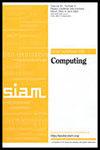纠错数据结构*
IF 1.6
3区 计算机科学
Q3 COMPUTER SCIENCE, THEORY & METHODS
引用次数: 0
摘要
我们研究存在对抗性噪声的数据结构。我们希望在一个简洁的数据结构中对给定对象进行编码,使我们能够有效地回答关于该对象的特定查询,即使数据结构已经被一定比例的错误破坏。我们根据数据结构的长度(表示中的比特数)和查询应答时间来衡量数据结构的效率,查询应答时间是通过对(可能损坏的)表示的比特探测数来衡量的。主要问题是这两者之间的权衡。这个新模型是(静态)数据结构和本地可解码纠错码(ldc)的共同概括。我们证明了各种自然纠错数据结构问题的上界和下界。特别地,我们展示了$t$探针纠错数据结构的最优长度,用于Membership问题(我们想要从一个大小为$n$的集合中存储大小为$s$的子集,以便可以有效地回答Membership查询)。本文章由计算机程序翻译,如有差异,请以英文原文为准。
ERROR-CORRECTING DATA STRUCTURES ∗
We study data structures in the presence of adversarial noise. We want to encode a given object in a succinct data structure that enables us to efficiently answer specific queries about the object, even if the data structure has been corrupted by a constant fraction of errors. We measure the efficiency of a data structure in terms of its length (the number of bits in its representation) and query-answering time, measured by the number of bit-probes to the (possibly corrupted) representation. The main issue is the trade-off between these two. This new model is the common generalization of (static) data structures and locally decodable error-correcting codes (LDCs). We prove a number of upper and lower bounds on various natural error-correcting data structure problems. In particular, we show that the optimal length of $t$-probe error-correcting data structures for the Membership problem (where we want to store subsets of size $s$ from a universe of size $n$ such that membership queries can be answered effic...
求助全文
通过发布文献求助,成功后即可免费获取论文全文。
去求助
来源期刊

SIAM Journal on Computing
工程技术-计算机:理论方法
CiteScore
4.60
自引率
0.00%
发文量
68
审稿时长
6-12 weeks
期刊介绍:
The SIAM Journal on Computing aims to provide coverage of the most significant work going on in the mathematical and formal aspects of computer science and nonnumerical computing. Submissions must be clearly written and make a significant technical contribution. Topics include but are not limited to analysis and design of algorithms, algorithmic game theory, data structures, computational complexity, computational algebra, computational aspects of combinatorics and graph theory, computational biology, computational geometry, computational robotics, the mathematical aspects of programming languages, artificial intelligence, computational learning, databases, information retrieval, cryptography, networks, distributed computing, parallel algorithms, and computer architecture.
 求助内容:
求助内容: 应助结果提醒方式:
应助结果提醒方式:


